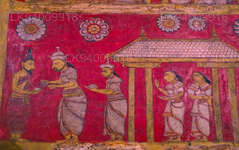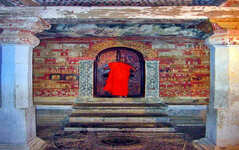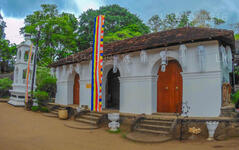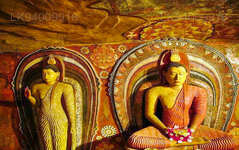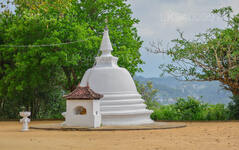
Kandy Şehri
Sri Lanka'nın merkezinde yer alan pitoresk bir şehir olan Kandy, zengin kültürel mirası, canlı festivalleri ve doğal güzellikleriyle ünlüdür. Yemyeşil tepelerin arasında yer alan Kandy, UNESCO Dünya Mirası Listesi'nde yer alan Diş Kalıntısı Tapınağı'na ev sahipliği yapar ve tarih ile doğal güzelliklerin büyüleyici bir karışımını sunar.
Degaldoruwa Raja Maha Vihara
Amongst the rocky slopes and green valleys of rural Kandy lies a hidden treasure; the Degaldoruwa Raja Maha Vihara. This temple awes those who view it with its incredible Kandyan era frescoes. Construction of the temple began in the late 1770s under the reign of King Kirti Sri Rajasinha and was completed under the reign of his brother Rajadhi Rajasinha years later.
Legend
According to folklore a farmer was exploring the area and found a crevice between two rocks. On venturing into space he found a cave with a pile of golden sickles. The farmer was delighted with his discovery but feared retribution from some strange power. So he simply took only one sickle every morning and, after using it in his fields, returned it in the evening. His fields yielded an extremely healthy harvest and the farmer attributed it to the golden sickle. But then he became greedy. After all, he had been taking the sickles every day and there had been no ill effects, and there was a whole pile of them. So on the very last day of the harvest, he took two sickles instead of one and did not return one of them.
But unknown to the farmer, there had indeed been a guardian for the treasure. The guardian noticed the farmer taking the sickles, but kept quiet as he always returned them. On the day that the farmer took one sickle for himself, the guardian saw it at once and confronted him in his home. The terrified farmer immediately rushed to the crevice and returned the golden sickle that he had stolen. The guardian, who had been disappointed, then sealed the crevice by fusing the two rocks together. However, the villagers got to know this story and informed the king, Kirti Sri Rajasinha; who then ordered that the cave be found and a temple erected in it.
The Structure
- The temple is hollowed out of a 40 foot rock outcrop extending a natural cave. It consists of an elegant rock shelter with two roofed antechambers in front; a drummers’ hall and an image house; and the main shrine room cut into the rock itself. The two antechambers are constructed outside the rock outcrop and have wooden roofs.
- The architecture is unusual for the period as the drummers’ hall is not usually attached to the main temple.
- The image house is located through a set of old wooden doors, situated under a carved wooden Dragon Arch. It preserves a moonstone and a sequence of elaborate and colorful paintings showing scenes from four Jātaka tales, which tell the stories of the previous lives of Buddha.
- The door of the shrine room is banded with metal and once had jewels embedded within it. The inner walls of the shrine are completely covered in paintings; including the door.
- In addition to this main structure, there is a bo tree and a stupa on a plateau on the summit of the rocky outcrop above the temple. They can be reached by stairs carved into the temple.
The Frescoes
The paintings of Degaldoruwa, which are supposed to be some of the best of the Kandyan era, are believed to be the work of four ‘Sittara’ artists. The finest of these paintings grace the ceiling of the temple; ‘Mara Yudde’, an artistic depiction of Buddha’s internal spiritual battle against Māra, the demon of death, rebirth, and desire.
The murals are unique in that all the elements; the people, the trees and the animals; are a uniform size and only the front views of ]people are shown. The trees have a stylized form, with their branches and leave spreading out to either side. The individual elements, such as the adornments on the elephants and the uniforms of the attendants, are portrayed in great detail. All of the colors used by the artists in the murals were created from the barks
Kandy Bölgesi Hakkında
Kandy bölgesi, Sri Lanka'nın merkez eyaletinde yer almaktadır. Sri Lanka'daki yedi Dünya Mirası Alanı'ndan biri olan Kandy, 16. yüzyılda Kandyan Krallarına ev sahipliği yapmış ve ülkedeki tüm müzik, sanat, el sanatları ve kültürün kaynağı olmuştur. Kolombo'ya yaklaşık 129 km uzaklıktaki Kandy, engebeli bir araziye yerleşmiştir ve tüm gözler, Kandy Gölü'nün büyüleyici bir özellik oluşturduğu şehrin merkezine çekilmektedir. Kandy, Sri Lanka için büyük dini öneme sahiptir, çünkü bu büyüleyici şehirde, Lord Buddha'nın kutsal diş kalıntısının iyi korunduğu Dalada Maligawa veya "Diş Tapınağı" bulunmaktadır. Peradeniya Kraliyet Botanik Bahçesi, şehir merkezinin yaklaşık 5 km batısında, Peradeniya'da yer almaktadır ve yılda 1,2 milyon kişi tarafından ziyaret edilmektedir. Adanın en büyük botanik bahçesidir. Udawatta Kele (Udawatta Ormanı), şehrin kalbinde, Diş Tapınağı'nın hemen kuzeyinde yer alan korunan bir sığınaktır. Kandy, Sinhalaların çoğunlukta olduğu bir şehirdir; Mağribiler ve Tamiller gibi diğer etnik gruplara ait önemli topluluklar da vardır. Kandy, Sri Lanka ekonomisinin merkezi olarak Kolombo'dan sonra ikinci sıradadır. Birçok büyük şirketin Kandy'de şubeleri bulunmaktadır ve tekstil, mobilya, bilgi teknolojisi ve mücevher gibi birçok endüstri burada bulunmaktadır. Şehirde birçok tarım araştırma merkezi bulunmaktadır. Ayrıca ülkedeki tüm müzik, sanat, el sanatları ve kültürün de kaynağıdır. Kolombo'ya yaklaşık 129 km uzaklıktaki Kandy, engebeli bir arazide yer almaktadır ve tüm gözler şehrin merkezine, Kandy Gölü'nün büyüleyici bir özellik oluşturduğu yere çekilir. Kandy, Sri Lanka için büyük bir dini öneme sahiptir, çünkü bu büyüleyici şehirde, Lord Buddha'nın kutsal diş kalıntısının iyi korunduğu Dalada Maligawa veya Diş Tapınağı yer almaktadır.
Merkez İl Hakkında
Sri Lanka'nın Merkez Eyaleti esas olarak dağlık bir araziden oluşur. Eyaletin alanı 5.674 km²'dir ve nüfusu 2.421.148'dir. Bazı büyük kasabalar Kandy, Gampola (24.730), Nuwara Eliya ve Bandarawela'dır. Nüfus, Sinhalese, Tamil ve Mağribilerin bir karışımıdır. Hem tepe başkenti Kandy hem de Nuwara Eliya şehri, Sri Pada ile birlikte Merkez Eyaleti'nde yer almaktadır. Eyalet, 1860'larda yıkıcı bir hastalığın eyaletteki tüm kahve plantasyonlarını öldürmesinin ardından İngilizler tarafından ekilen ünlü Seylan çayının çoğunu üretmektedir. Merkez Eyalet, Kandy, Gampola, Hatton ve Nuwara Eliya gibi tepe istasyon kasabalarıyla birçok turisti çekmektedir. Tapınak dişi veya Dalada maligawa, Merkez Eyaleti'ndeki ana kutsal mekandır. İklim serindir ve yaklaşık 1500 metre yükseklikteki birçok alanda genellikle soğuk geceler olur. Batı yamaçları oldukça yağışlıdır ve bazı yerlerde yılda yaklaşık 7.000 mm yağış görülür. Doğu yamaçları ise sadece Kuzeydoğu musonundan yağış aldığı için orta kurak bölgenin bir parçasıdır. Sıcaklıklar, deniz seviyesinden 1.889 m yükseklikte bulunan Kandy'de 24°C ile Nuwara Eliya'da sadece 16°C arasında değişmektedir. Sri Lanka'nın en yüksek dağları Merkez Eyaleti'nde yer almaktadır. Arazi çoğunlukla dağlık olup, derin vadiler araziyi kesmektedir. İki ana dağlık bölge, Kandy'nin doğusundaki Merkez Masifi ve Knuckles Sıradağları'dır.


